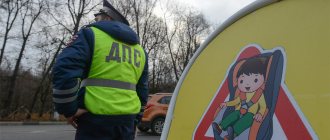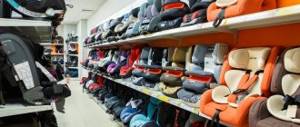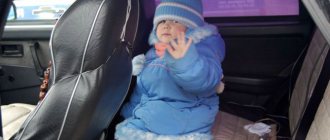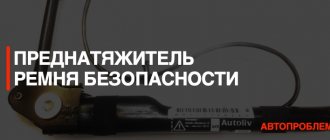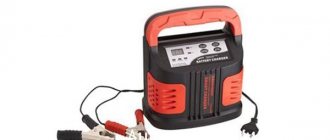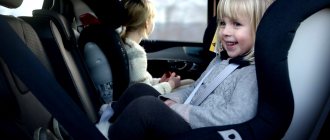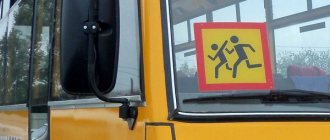According to traffic rules, the driver must wear seat belts when driving and not carry unbelted passengers. Particular attention is paid to the safety of transporting children. Let's look at it in detail:
- What is a "Child Restraint"
- What devices can be used
- Rules for installing restraint devices in cars
- What rules for transporting children were in force before July 2017?
- Rules for transporting children in a car 2020
- Is it possible to use a “booster” when transporting children?
- Fine for a child seat (lack of one)
What is a "Child Restraint"
The concept of a child restraint system is given in GOST R 41.44-2005 ().
According to this standard, a child restraint system is a set of elements consisting of:
- straps or flexible elements with buckles;
- control devices;
- fastening parts;
- and in some cases, an additional device (for example, a bassinet, a removable child seat, a booster seat, and/or an impact shield) that is attached to the interior of the vehicle body.
The device must be designed so that in the event of a collision or sudden braking of the vehicle, it reduces the risk of injury to the child and limits his mobility.
Child restraints are divided into five weight groups:
group 0 (group 0) - for children weighing less than 10 kg; group 0+ (group 0+) - for children weighing less than 13 kg; group I (group I) - for children weighing 9-18 kg; group II (group II) - for children weighing 15-25 kg; group III (group III) - for children weighing 22-36 kg.
Types of child restraints in the car
Child restraint equipment combines a number of functions.
Firstly, the device must protect the baby as much as possible during sudden braking, an unexpected maneuver or an accident.
Secondly, the device should be as comfortable as possible for the baby. After all, if the baby becomes restless, he will begin to distract the driver. And such a situation can turn into an incident.
And thirdly, the equipment must comply with European standards. Let's take a closer look at them.
Type of equipment:
- 0 for child weight 0–10 kg
- 0+ for child weight 0–13 kg
- 1 for a child weighing 9–18 kg
- 2 for a child weighing 15–25 kg
- 3 for a child weighing 22–36 kg
Manufacturers make different models suitable for children of different age groups. Let's take a look at the main categories:
Category 0 and 0+
Photo from wiki.zr.ru
In another way they are called infant carriers. Such devices are suitable for children from one to one and a half years old.
Category 0+ and 1
Photo from wiki.zr.ru
This type of equipment is used for children from birth until the age of four. Please note that the chair can be installed in any direction.
Category 1
Photo from wiki.zr.ru
This type includes both child seats and seats. Used from nine months to four years of age.
Categories 2 and 3
Photo from wiki.zr.ru
This equipment is equipped with a height adjuster for the headrest and backrest. Designed for children from three to twelve years old.
Categories 1, 2 and 3
Photo from wiki.zr.ru
These chairs have a five-point harness, a sophisticated design that allows you to adapt the device to the size of the child. Suitable for children from several months to 12 years.
Booster
Photo from wiki.zr.ru
This device is structurally different from conventional car seats. The booster has no back. The seat helps protect the baby by elevating the baby. As a result, a standard three-point belt does not put pressure on the child’s neck and becomes absolutely safe.
An indispensable advantage of such a device is its compactness, low cost and comfort. But there were some shortcomings. The booster is inferior in safety to a regular car seat. Despite this, the device protects the child better than the standard car safety package. Boosters are classified into categories 2 and 3. Accordingly, children from three to twelve years old can be in such seats.
The booster can be placed both in the front and on the rear seat of the car. The most convenient and safe place is in the middle of the back row. When installing the device, the seat belt must be adjusted correctly. The strap should not be on the child’s neck.
FEST
Photo from the site provodim24.ru
This restraint equipment for children in a car is one of the cheapest and, accordingly, in demand on the market.
A regular car seat belt is designed for passengers over one and a half meters tall. FEST is essentially an ordinary adapter. The device adjusts the straps so that the belt does not put pressure on the child’s neck.
The equipment has been certified in the Russian Federation, so you can safely use it without worrying about the safety of the child or a fine from the traffic police.
There are two opinions online about this device. Repeatedly in famous automobile programs such as Auto Review or Main Road, the safety of the device was discussed. However, watching crash tests using such a device does not inspire hope.
FEST can be used to avoid a fine from traffic police officers. However, to ensure the safety of the child, it is better to use proven car seats.
Installation of car seats
When installing infant carriers, that is, devices of categories 0 and 0+, you should turn the child with his back to the windshield. This will help avoid neck injuries when stopping abruptly. With this installation, the child's neck will not tip forward during sudden braking. The chair can be installed either from the back or from the front.
Important
If your car has airbags, you should definitely turn them off when transporting children in the front passenger seat. A pillow that suddenly flies out can cause serious injury to a child.
Car restraints are attached to the seat using a standard seat belt entry, or using an Isofix mount specially designed for this purpose.
Photo from wiki.zr.ru
Isofix implies the presence of special fastenings in the vehicle. It greatly helps the driver when installing the seat, and also protects the restraint device from tipping over. Unfortunately, not all cars are yet equipped with such devices.
In category 0, 0+ and 1 devices, the car's stationary seat belts are secured with a clip. In this case, the child is held in place by a belt built into the chair.
Equipment of categories 2 and 3, including boosters, is mounted in the car using standard seat belts. As for the booster, the straps should go through the armrests.
Seat belt adapters, such as FEST, clip onto the seat belt straps. Further adjusted depending on the height and dimensions of the child. It is important to adjust the adapter so that the strap of the harness passes from the child's stomach over the shoulder. Under no circumstances should the strap come into contact with the baby's neck.
Photo from wiki.zr.ru
Some brands offer a car seat as a separate option in their latest models. By paying an additional amount you will receive a removable child seat located on the rear sofa. Typically, such devices are designed for children over one year old.
What should you pay attention to when purchasing a child restraint system for your car?
To be calm about the safety of your child on the road, you should not save money and buy Chinese counterfeits. The media report frequent precedents of injuries, mutilation, and sometimes death due to a malfunction of a Chinese car seat during a traffic accident.
The purchase of restraint devices should be made in specialized stores with a wide assortment. Check used car seats carefully. Such copies may be defective or faulty.
Before visiting the store, you should find out the exact weight and height of the baby. This will make it easier to select the size of the device.
When choosing, pay attention to the presence of adjustments. With the seat adjusted correctly, the baby will feel comfortable and will not disturb the driver. It is also worth looking towards models with removable upholstery. This will make the process of washing the chair easier in case of an unexpected incident.
What devices can be used
The device can be used if:
- it corresponds to the weight and height of the child;
- its design complies with GOST R 41.44-2005.
Child restraints can be of two types: one-piece and non-one-piece.
One-piece retention devices. They are a set of all the elements necessary to secure the child in the device. Examples: bassinets, car seats.
Non-integral restraint devices. Includes a partial restraint that is used in conjunction with an adult seat belt to form a complete child restraint. Examples: boosters and seat belt adapters.
Rules for installing restraint devices in cars
Statistically, the safest place is the middle seat of the back row. The most dangerous is the front passenger seat. Consider this information when arranging restraints in your vehicle.
Car seats can be installed both in the front passenger seat and in the rear.
If you install a seat in the front, be sure to take into account the design of your car. If it has a front passenger airbag, it must be disabled for rear-facing child seats.
Location inside the car
ISOFIX child seat anchors are located on the rear seats of the car, in the corner between the backrest and the passenger seat. Usually these places have corresponding signs.
You can pull back the upholstery, and if the fastener is installed there, it is easy to detect by touch.
They often have attachments that are removed when installing the car seat.
ISOFIX on the front seat
Some car owners are wondering: is ISOFIX available in the front passenger seat?
To everyone interested, we answer: NO .
Let's look at why automakers don't install such a system at the front.
As noted earlier, the ISOFIX retaining brackets are welded directly to the car body, which means that it is simply impossible to install them on the front seat, otherwise the seat will stop moving and reclining.
If you still decide that you definitely need ISOFIX on the front seat, contact your dealer; perhaps, at your request, the desired additional option will be provided. Or you can complete your car yourself - buy the appropriate factory mount or, showing the wonders of engineering, come up with your own design.
But remember! The front seat anchor you create will likely add stability to the child car seat, but will not provide adequate safety for the child.
What rules for transporting children were in force before July 2017?
You can transport children in a car provided that their safety is ensured. In this case, the design features of the vehicle must be taken into account.
Children under 12 years of age can be transported in cars equipped with seat belts only using child restraints that correspond to the weight and height of the child, as well as other means that allow the child to be fastened with the seat belt provided in the car.
Transportation in the front seat of a passenger car is permitted only with the use of child restraints (clause 22.9 of the Russian Traffic Regulations).
Results
- You should not take a formal approach to the choice of a child restraint, setting yourself the goal of simply complying with traffic regulations and not having problems when checking your car by traffic police officers.
- Thanks to the new changes in traffic rules, motorists have the opportunity to transport children aged 7 to 12 years, without any special restraints at all, just put the child in the back seat of the car and fasten it with a regular seat belt.
- But you should still remember that a car is considered a source of increased danger and, when going on the road with a child, you should first of all take care of the safety of the child passenger, and here you cannot do without appropriate restraint devices.
Rules for transporting children in a car 2020-2021
On July 10, 2017, amendments to the Traffic Rules of the Russian Federation regarding the requirements for transporting children, approved by Decree of the Government of the Russian Federation dated June 28, 2017 No. 761 (), came into force.
According to these requirements:
Transportation of children under the age of 7 years in a car and a truck cab that is designed with seat belts or seat belts and an ISOFIX child restraint system must be carried out using child restraint systems (devices) that are appropriate for the weight and height of the child.
In other words, only in a car seat.
Children aged 7 to 11 years (inclusive) must be transported in a car and truck cab using a car seat or using seat belts, and in the front seat of a car - only in a car seat.
In addition, according to current rules, it is prohibited to leave a child under 7 years of age in a car while it is parked in the absence of an adult (clause 12.8 of the Russian Traffic Regulations).
Legislative framework
The mandatory use of child restraints in cars is established at the level of Russian legislation. According to paragraph 22.9 of the traffic rules, transportation of children under 7 years of age in a passenger car or truck cab must be carried out using child restraint systems that correspond to the height and weight of the child.
Small passengers aged 7 to 12 years are allowed to be transported by traffic rules without restraints, fastened with a standard seat belt. However, transportation should only be carried out in the back seat of the car. If a child is in the front seat, the use of a child restraint system remains mandatory.
For violating clause 22.9 of the Traffic Regulations of the Russian Federation, the driver will be fined in accordance with Part 3 of Clause 12.23 of the Code of Administrative Offenses of the Russian Federation. For individuals, the fine will be 3,000 rubles, for officials responsible for transporting children - 25,000 rubles, for legal entities - 100,000 rubles.
Is it possible to use a “booster” when transporting children?
Boosters can be used when transporting children if the device meets the requirements of GOST R 41.44-2005 (Russian standard PCT) and is selected in accordance with the weight and height of the child being transported. When preparing this material, a request was sent to the traffic police to clarify this issue. The answer is attached below:
Fine for a child seat (lack of one)
For transporting children in a car in violation of these rules, a fine is provided - Part 3 of Art. 12.23 Code of Administrative Offenses of the Russian Federation.
- a fine for the driver in the amount of 3,000 rubles;
- for officials - 25,000 rubles;
- for legal entities - 100,000 rubles.
according to article
Write to our lawyer and he will help you understand automobile legislation. We will consider controversial situations and tell you how to act according to the law.
Don't miss new useful publications
We will tell you about the intricacies of the legislation, help you understand it and tell you what to do in controversial situations.
